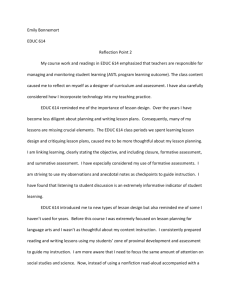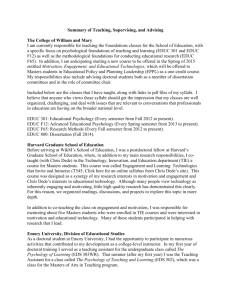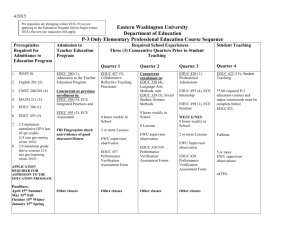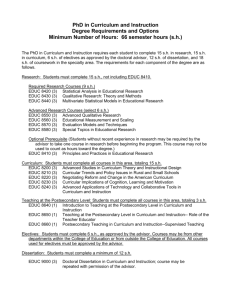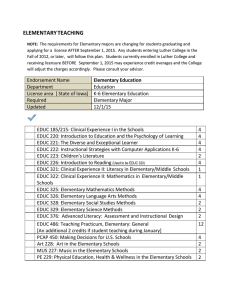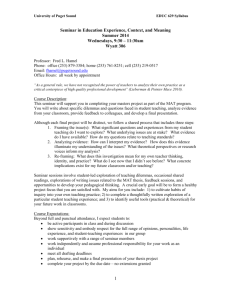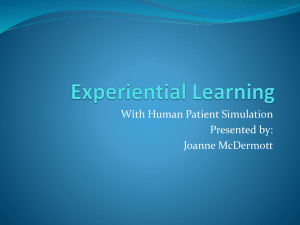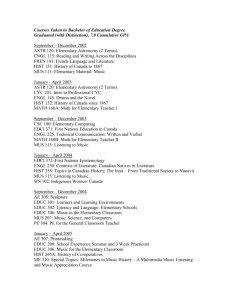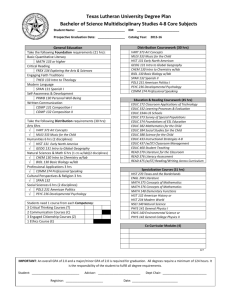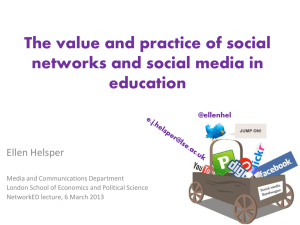EDUCATION
advertisement
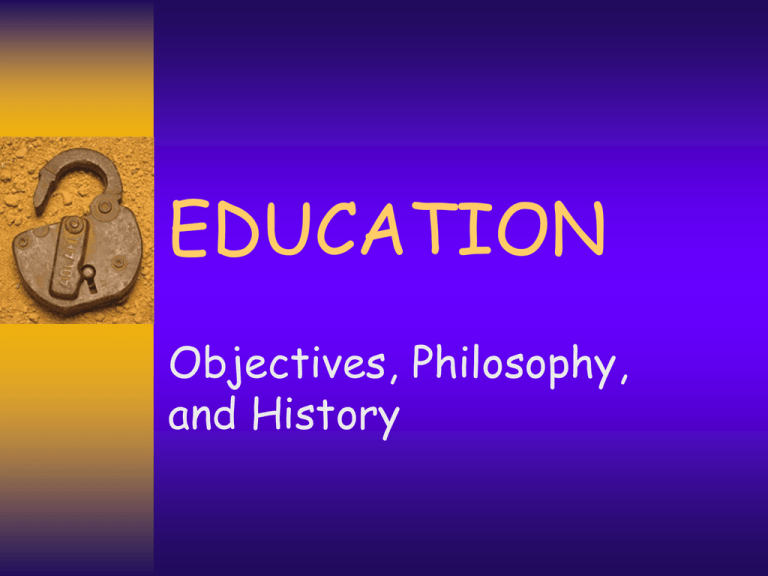
EDUCATION Objectives, Philosophy, and History “Just as the body does not develop, fully without exercise, neither does the mind.” -David Brinkerhoff and Lynn K. White NATURE OF EDUCATION The basic purpose of education is the transmission of knowledge. Education was originally a family responsibility, but industrialization changed that dramatically. Advanced education is regarded as a necessity for a large portion of the population. DEFINITION Education is the social responsibility for the transmission of knowledge, skills, and cultural values with a formally organized structure. OBJECTIVES OF EDUCATION 1. The development of human talents and personal character for better citizenship. 2. the gearing of the educational system to the requirement of socio-economic growth. 2 FUNCTIONS OF EDUCATION Manifest Function > defined as the open states and intended goals or consequences of activities within organization of institution. 1) 6 Major Manifest Functions: 1. 2. 3. 4. 5. Socialization Social Control Social Placement Transmitting Culture Promoting Social and Political Integration 6. As an Agent of change 2. Latent Function 1. Restricting some activities. 2. Matchmaking and Production of Social Networks 3. Creation of Generation Gap 3 Functions of the School identified by John S. Brubacher Conservative Function Progressive Function Neutral Function As formulated by the Board of National Education, the following comprise the broad and specific aims of education: 1) To inculcate moral and spiritual values inspired by an abiding faith in God; 2) To develop an enlightened, patriotic, useful, and upright citizenry in a democratic society; 3) To instill habits of industry and thrift, and to prepare individuals to contribute to the economic development and wise conservation of the nation’ natural resources; 4) To maintain family solidarity, to improve community like, to perpetuate all that is desirable in our national heritage and to serve the cause of world peace; and 5) To promote the sciences, arts, and letters for the enrichment of life and the recognition of the dignity of the human person. EDUCATION IN THE PHILIPPINES: A HISTORICAL DEVELOPMENT 1901-1910 1. Under the American Civil Government, free primary education was introduced to the country 2. First public school were established 3. The Department of public instruction introduced 3-level system of education: 7 years basic elementary education, 4 years secondary education, and 2 years junior college. 4. UP, Phil. School of Arts & Trades, and PNU were established 1. 1911-1920 1. 1. Private school flourished 2. In 1911, the Private School Law Act 2706 was enacted. It made obligatory the recognition and inspection of private schools and colleges to maintain a standard of efficiency in all private schools and colleges. 1921-1930 1. The government prepare and adopt basic textbooks for all schools. 2. In 1925, a study on the development of education in the Philippines was conducted. 3. Industrial and agricultural secondary schools were organized. 4. Military training for males in secondary schools were organized. 5. Military training for males in secondary schools introduced. 1931-1940 Commonwealth Period Passage of the Education Act of 1940 which provided for the complete revision of the republic elementary school system of the country. 1941-1950 1. Filipino teachers were ordered to delete parts of textbooks, which had references to the US and Britain and democratic principles 2. In 1947, the Department of Public was enacted Creating the Board of Textbooks. 1951-1960 1. Elementary Education Act repealed Commonwealth Act 586, thus restoring Grade 7 which, double-single session was abolished and classes reverted to the “Each One Teach One” process. 2. All education institutions were required to have a daily flag ceremony 3. Prescribing the inclusion of a course on the life works and writings. 1961-1970 1. Magna Carta for Public School Teachers was approved to promote and improve the social and economic status of public school teachers. 2. In 1961, Pres. Marcos created the Presidential Commision to Survey Phil. Educ.(PCSPE). It recommended the overhaul of the educational system. 1971-1980 1. In 1972, Dept. of Education was named Dept. of Education and Culture. 2. Pres. Marcos passed Presidential Decree 1006, declaring teachers as professionals and teaching a profession. 3. In 1974, the National College Entrance Examination (NLEE) was implemented. 1981-1990 1. In 1982, the ministry of Educ., Culture and Sports 2. Program for Decentralized Educ. Development (PRODED) 3. Educ. Dept. ordered the abolition of youth Civic action Program (YCAP) 4. In 1986, Pres. Aquino’s term, MECS was renamed Dept. Of Educ., Culture and Sports (DECS) 5. Public Secondary Education 6. Gov’t. subsidy to pivate education known as the Private Educ. Student Financial Assistance (PESFA) 7. Provision of loan assistance to poor 8. Expansion af alternative school systems for tribal minorities and the disabled 9. Launching of Values Education Program 10. Secondary Educ. Dev’t Proram (SEDP) was launched starting with first year level in SY 1989-1990 11. In 1990, Pres, Aquino formed the Commission on Education (EDCOM) 1990 to Present 1. In 1991, the Education for all (EFA) program was launched. 2. In 1993, first National Elementary Achievement (NEAT) was conducted. 3. Implementation of National Secondary Assessment Test (NSAT) 4. In 1944, Pres. Ramos, lengthen the school calendar from 200 to 220 days 5. In 1995, Technical Educ. and Skills Development Authority (TESDA) was instituted. 6. Non-formal Educ. Mobile Program 4. Lingua Franca Educ. Project 7. DECS implemented the Third Elementary Educ. Project. DECS and CHED: THRUSTS UNDER THE MEDIUM TERM PHILIPPINES DEV’T PROGRAM OR ANGAT PINOY 2004 According to Functional Literacy Education and Mass Media Survey (FLEMMS) o 2.8 million- basically illiterate - barely able to read, write or even worse o 7.8 million- functionally illiterate unable to participate fully and efficiently in everyday activities that require reasonable skills or capabilities. EDUCATIONAL ACTION PLAN: THE MISSION OF ANGAT PINOY 2004 I. ON BASIC EDUCATION A. DECS’ formula -Education on literacy (EOI) 1. Non-formal Education Accreditation and equivalency System (Project Ease) - For elementary pupils, the system has instituted the dropout intervention program provides young school children with everything that they need for school. - For H.S. students, there is Project EASE, which enables dropout H.S. students to return to school whenever they are ready. 2. Balik Paaralan 3. Instructional program -Accredition and Equivalency Test(A & T) a) Language Policy b) Teaching Math, Science and IT c) Testing 4. Computerization of the payroll system and devolving it to the regions. 5. Creating and maintaining a management information system for governance 6. Rethinking and replanning the IT and its implementation. 7. Getting the 16 regional H.S. 8. Preparing divisions and districts for empowerment 9. Ensuring a liberal education in critical thinking for faculty and administrators; rediscovering the value of reading for basic education. 10. Alternative Schools for out-ofschool youth an d returnees including the medium or instruction. 11. Ensuring a cadre of intellectuals and leaders for DECS in next century ESTRADA Government’s Medium-term Philippines Development Plan Objectives: 1. Expanding access to basic education 2. Improving the quality an relevance of basic education; improved basic literacy 3. Improving the efficiency and effectiveness of the system and of the schools 4. Institutionalization of early childhood Care and Development (ECCD) 5. Strengthening local culture, arts and school sports B. CONGRESSIONAL FORMULA. Enabling laws – A necessity 1. Creation of the Commission on Preparatory School Education Article XIV, Section 2(1) of the 1987 Constitution provides: “The State shall establish, maintain, and support a complete, adequate, and integrated system of education relevant to the needs of the people and society.” 2. Education Initiatives Act Article XIV, Section 1 provides: “The State shall protect and promote the right of all citizens to quality education at all levels and shall take appropriate steps to make such education accessible to all.” II. ON HIGHER EDUCATION A. CHED’S Thrusts 1. Strengthening public and private HEIs identified as Centers of Excellence (COEs) and Centers of Development (CODs) in nine clusters of disciplines; 2. Accelerating the restructuring and streaming and lining of public higher education sub-system; 3. Imposing a moratorium on the conversion into and creation of SUCs and rationalizing funding allocation for the public higher education institutions; 4. Establishing a viable Quality Assurance system in higher education; 5. Developing innovative programs in higher education and alternative modes of delivery of educational services; 6. Strengthening research and extension function of HEIs; 7. Raising of Maritime Education Standards in compliance with international standards, particularly the 1995 Standards of training , Certification and Watchkeeping for Seafarers; and 8. Raising the global Competitiveness of HEIs. B. Congressional Action 1. Open Tertiary Education Act Article XIV, Section 2(2) provides that: “The State shall establish, maintain, and support a complete, adequate, and integrated system of education relevant to the needs of the people and society.” -Open Tertiary education is a system of delivery or acquiring education other then the graded, structured, and class-attended formal systems, mode of delivery/acquisition may include but not necessarily limited to, the use of radio, television, print media, audio/video equipment, face to face interaction, observation, etc, at a place and place of study determined by the student himself. (Osmena III, Senate Bill No. 176). The Human Rights Education Act. 2. Article XIV, Section 3 (2) states that: “All educational institutions shall foster love of humanity and respect for human rights…” - July 4, 1986 – Pres. Aquino promulgated Executive Order No. 27 DECS Sec. Lourdes Quisumbing issued order No. 61 S. 1987 What are the Identifiable Problems of the Education System? 1. Low Budget, High Enrollment 2. Shortage of Faculty Members 3. Reading materials for instruction 4. Classroom Shortage Factors Affecting Education 1. The Priorities of law and order directed by the police and the demands of national security as defined by the military siphon off a lot of funds. 2. The automatic debt service takes a huge chunk off our scarce national resources

